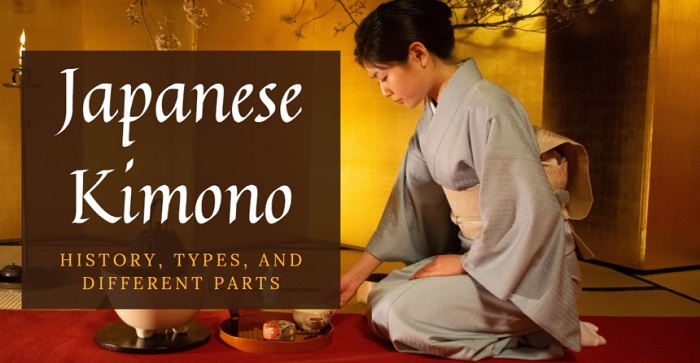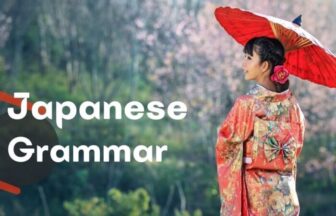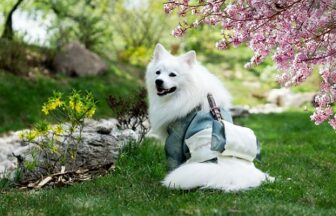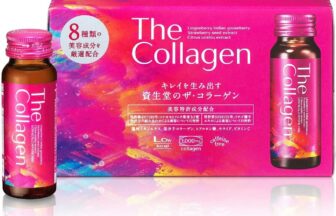A Japanese kimono is one of the world’s recognizable traditional garments. For sure, you are familiar with the kimono. It is popular for many reasons, mainly for being versatile since they could easily be layered or altered to suit any season.
But have you ever wondered how a kimono would look on you? That’s probably one good reason to have it on your bucket list. You can’t assume to have completed your Japanese experience unless you take on this traditional fashion as well.
History of Japan’s Kimono
The word is derived from the verb ki which means “to wear” and the noun mono which means “thing”. In other words, kimono literally means “clothing”
Kimonos came into being during the Heian period. Over time, as this practice came into fashion, Japanese people began paying attention to how kimonos of different colors looked together; that’s when they have developed a heightened sensitivity to color. Thus, color combinations began to represent either seasonal colors or the political class to which one belonged to. For example, warriors dressed in colors that represented their leaders.
During the Meiji Period, Kimono fell out of fashion when the government encouraged people to adopt Western clothing styles.
Nowadays, Japanese people rarely wear kimonos as an everyday thing. But these are reserved for occasions such as weddings, funerals, tea ceremonies, or other special events, such as Japanese festivals.
Parts of a Kimono
Talk about a complex puzzle. Kimonos aren’t as easy as wearing fitted jeans and a simple tee and jacket. It consists of several parts that if you were missing one piece of the puzzle, then the whole outfit won’t work.
Here are the parts of a kimono that even you, as a foreigner, should know:
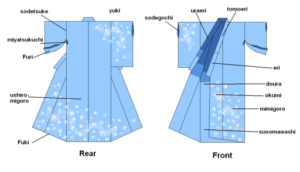
Astridvincent, CC BY-SA 3.0, via Wikimedia Commons
Front Parts
- Sode – the sleeve of the kimono; it’s broken down into a few parts: furi, tamoto, sode-guchi, sode-tsuke, etc. There are also several lengths of sode.
- Sode-guchi – the armholes
- Ura-eri – the inner lining of the collar
- Tomo-eri – the over-collar or collar protector; as stains are more likely to occur on the eri, the tomo-eri is a piece of fabric that protects it and can be replaced if damaged, or changed if a different color is desired.
- Eri – the collar of the kimono
- Do-ura – this inner, unseen lining is simple for female kimono, but often more decorative in men’s kimono. According to a historical context, wealth was based on how detailed the inner lining was.
- Okumi – a gusset, or a panel on the front edge of the left and right, excluding the sleeve of a kimono, added to make the front wider than the back.
- Mae-migoro – the front panel of the kimono, excluding the sleeves.
- Suso-mawashi – the lower lining of a kimono; often with an elaborate decoration that can be seen when the okumi opens.
Back Parts
- Sode-tsuke – the inner armhole of the kimono
- Yuki – the measure of distance from the center seam in the back of the kimono to the sleeve’s edge
- Fuki – the hem guard at the very bottom of the kimono
- Ushiro-migoro – the main back panel (Ushiro means “back”); they are basically sewn back-centered and consist of “right ushiromigoro” and “left ushiromigoro”; but for wool fabric, the ushiromigoro consists of one piece.
- Furi – the unsewn lower part of the sleeve that can swing (used by dancers or by kabuki actors as props)
- Tamoto – the pouch inside the furi part of the sleeve; this small space can be used to hold things like a handheld fan.
- Miyatsu-kuchi – only found on a female kimono; this is the small opening under the sleeve that’s used when adjusting how the kimono fits
Additions:
- Nagajuban – basically the undershirt or slip of the kimono.; shaped like a kimono, these garments protect the colorful (and often expensive) kimono which are difficult to clean. Therefore, it’s necessary to wear an inner garment to protect the kimono from sweat and then wash it as necessary, keeping the kimono clean.
- Obi – is the “belt” that holds the fabric tight. The obi hides away any excess fabric and (for women) helps keeps the wearer’s waist small and posture straight (similar to a corset). Men’s obi is much simpler, thinner, and less restrictive. They also come in fewer styles than female obi.
- Koshihimo – which means “hip ribbon,” is a thin piece of fabric that is used to hold the kimono together before tying the more complicated obi. These silk, wool or soft cotton cords are not seen on the outside, but rather are under the obi.
- Footwear – The kimono set isn’t complete without traditional footwear. Here are the terms you need to know:
- Tabi – traditional split-toe socks, generally in white.
- Zori – thonged sandal-like shoes that were traditionally made from straw. However, they are also made of fabric, brocade, rubber, or vinyl.
- Geta – wooden sandals that seem to fit between clogs and flip-flops. Geta, which are elevated from the ground with wooden supports (or teeth). Maiko, or geisha apprentices, are well-known for wearing a high-wedge version of geta called okobo.
Different Types of Kimonos
1. Furisode
Furi means “swing” and sode means “sleeve”. Yes, the highlight of its design is the very long and large sleeves that cover the hands; the length can fall down to 39 to 42 inches. For what purpose? Well, since the Edo period, swinging large sleeves became a means of showing sentiment.
Additionally, this Kimono style is designed for unmarried women who are mature and ready to get married. They are worn on formal occasions such as voting, weddings (as the bride’s family member), tea ceremony, or the coming of age ceremony. This kimono type adorns women with its high-quality silks and brightly colored patterns that cover fully the whole garment.
Furisode is categorized into 3 types (based on the sleeves’ length):
- Kofurisode (short sleeves)
- Chu-furisode (medium sleeves)
- Ofurisode (sleeves almost reach the ground)
2. Tomesode
Unlike the Furisode, Tomesode is the type of Kimono made for married women whether they divorced or not. It is worn on important occasions meant for their family or relatives such as weddings.
This Kimono style is designed with short and narrow sleeves. Notably, it has an embroidered family token on it. They always have crests and patterns which may incorporate gold and silver, found only below the waist.
There are two kinds of Tomesode:
- kuro (black) – most formal, and always have five crests
- iro (coloured) – any base color other than black, and may have one, three, or five crests
3. Houmongi
In Japanese, houmon means “visiting”. Houmongi is worn by women (often unmarried women) on formal occasions such as weddings (as the bride’s friend), tea ceremonies, other formal parties. It is less formal than tomesode but more formal than tsukesage or komon kimonos. Japanese parents often buy houmongi as a gift for their daughters before they get married.
The kimono’s body design is in plain color with the same patterns in the shoulders, sleeves, and lower lap of kimono.
4. Tsukesage
Tsukesage is the type of Kimono that is worn by married women during tea ceremonies, flower arrangement meetings, and a friend’s wedding.
The design of Tsukesage resembles much to that of the houmongi. The only difference is that the patterns of Tsukesage are more modest and cover a smaller area than the houmongi’s does.
5. Iromuji
This type may be less popular but it is probably the easiest type of kimono to wear. They are most appropriate for tea ceremonies and the level of formality is determined by the absence or presence and the number of crests.
Iromuji means “plain color” and can have any color, except black and white. It also has no other patterns except submerged woven pattern on the fabric (if sewn from rinzu).
This kimono type can be worn by both married and unmarried women, and the older women are, the more elegant colors will be preferred.
6. Komon
Komon, which literally means “small pattern”, has repeated patterns throughout the garment with no particular direction or layout. This kimono style is more casual and can be worn around town. The fabric is very diverse, ranging from silk, wool, polyester to rayon.
Komon is worn by married and unmarried women. It can also be worn by men.
7. Mofuku
This type of Kimono is solid black, and all the accessories are also in black. They wear a complete plain back silk with five crests over white undergarments and white tabi.
Obviously as the color implies, Mofuku is a formal mourning dress for men or women. The completely black mourning ensemble is usually reserved for family and others who are close to the deceased.
8. Uchikake
Uchikake is a very formal kimono worn by brides or stage performers. It is worn outside the actual kimono, so it is never tied with an obi. Its design (mainly bridal costume) uses red or white as the base colors. This dress is longer than other types of Kimono, and often trails the floor.
9. Shiromuku
This type of Kimono is the most complicated to put on and is worn in a traditional wedding. The dress is very long and trails the floor in the circle, so a bride needs assistance to walk steadily.
In contrast to Mofuku, Shiromuku and all the accessories including a headdress called tsunokakushi and chonmage (a kind of traditional topknot) are all in white – the color of purity and maidenhood of the bride coming into the marriage.
10. Susohiki
The susohiki, also known as Hikizuri is usually worn by geisha or by stage performers of the traditional Japanese dance.
Like Shiromuku, the dress measures up to 2m (about 6.6 ft), and trails the floor. Normally, the kimono collar is a fist-size down from the nape of the neck, but Susohiki’s collar is even lower than this. In order not to show the pulled-down collar, the seam between the shoulders and sleeves are longer in the front than in the back.
11. Juunihitoe
Juunihitoe is an extremely elegant and highly complex type of kimono that was only worn by Japanese court-ladies. That explains why this Kimono type is among the most expensive Japanese clothing.
The Juunihitoe consist of various layers which are silk garments, with the innermost garment being made of white silk. Today, Juunihitoe can only be seen in movies, museums, festivals, or in some important events of the Imperial Household.
12. Yukata
Interestingly, Yukata may be the most simple yet well-known type of Kimono to foreigners. It is easier to wear and maintain and is less expensive. It is a type of kimono made of ordinary cotton, used in summer.
Compared to Furisode, Yukata is much simpler. As a result, Japanese women know how to wear it without help just after learning several times.
In the past, the traditional Yukata usually had only two sets of colors: white – black or blue-white, but in the last few years this kimono style has been designed in many eye-catching colors. In ancient times, Yukata was only used at home as bathing wear, but today, Yukata is often worn by both men and women (of any type of age) on summer festivals.
13. Odori Katamigawari
Odori means “dance”. So, this is a traditional Japanese dancer’s kimono. Katamigawari means half and half, referring to this kimono being half one design and half another, which is more likely to be seen on an odori kimono than any other. Many odori kimonos are tsukesage, houmongi or komon in style. They are often in synthetic textiles, so they can, unlike silk, be washed regularly and they are most frequently unlined or just lower lined, to keep the dancer cooler
Free Kimono experience in Tokyo
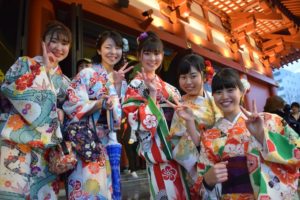
YES! There is a free Kimono experience that exists in Tokyo. If you head on to the Japan National Tourism Organization (JNTO) office and you can borrow them for free!
You will also be assisted in putting the kimono on.
Take a picture or two, and upload it on your Instagram! It’s not every day you get to be Japanese.
Opening hours: Everyday 9 am – 5 pm
Address: 1st Floor, Shin-Tokyo Building, 3-3-1, Marunouchi, Chiyoda-ku, Tokyo (Exit 6 of JR Tokyo Station)
*If this isn’t available nowadays, well you can always search for a kimono rental where costs would be worth several hours.
The Japanese Kimono has existed for hundreds of years. Up till today, it is still a huge representation of Japan’s culture and heritage. But it is usually worn only on important holidays and events. You might just notice that women wear kimonos more regularly than men do because men wear this primarily for weddings and tea ceremony ceremonies. But as a foreign traveler, you get the chance to experience this on your visit.
FAIR Japan provides useful information about Japan.
